Oksana Lushchevska: An International Collaboration
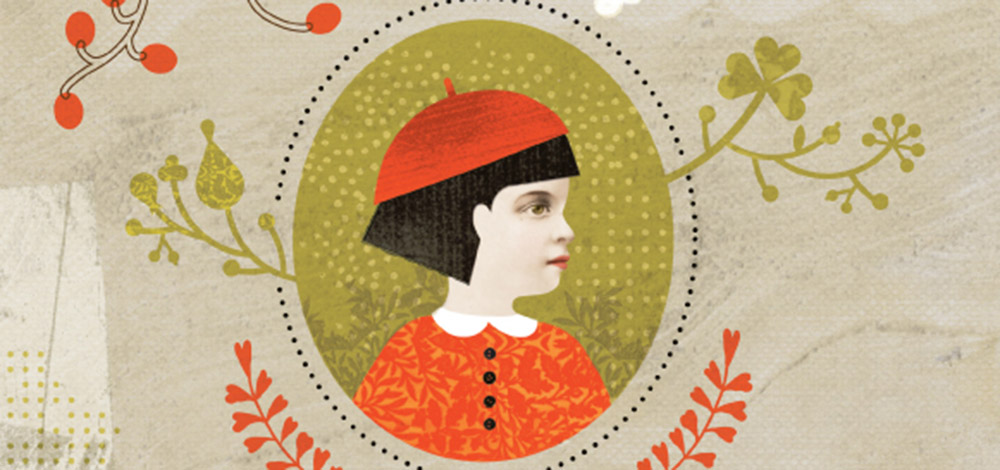
What a treat I have for readers today, especially those of you who, like me, enjoy following international picture books. In fact, next week is the Bologna Children’s Book Fair in Italy (how I wish I were going!), so the timing of this post is particularly good.
Today, I welcome Oksana Lushchevska, a PhD student in Reading, Writing, Children’s Literature, and Digital Literacy in the Department of Language and Literacy Education at The University of Georgia. She is contributing a guest post on contemporary Ukrainian children’s literature. Oksana’s doctoral research is focused on international children’s literature, and she also translates picture books from Ukraine into the English language, some of which have been awarded the Bologna Ragazzi Award. She also works with a private publishing house in Ukraine, creating bilingual picture books for children.
Oksana reached out to me to see if she could write here at 7-Imp about Ukrainian picture books. “I strongly believe that contemporary Ukrainian children’s literature might be of interest in the U. S.,” she told me, “especially bilingual picturebooks and award-winning translations.”
I was so pleased she contacted me; I’m glad to have met her, if only online; and I am grateful she is contributing this post today, especially since it’s filled with art. She calls this piece “Contemporary Ukrainian Children’s Picturebooks: Why Shouldn’t We Welcome Them?” Let’s get right to it …
* * *
Oksana: First of all, I am very thankful to Jules for this wonderful opportunity to introduce contemporary Ukrainian picturebooks on her marvelous blog, which I’ve been following for quite a while. To briefly introduce myself, I’d say that I can surely call myself a children’s literature enthusiast, and my involvement in children’s literature is multifold. I must admit that all my activities often divide my daily routines into two parts: my “Ukrainian” phase of the day and my “American” phase of the day (because of the seven-hour time difference). It is sometimes really challenging, but is also very interesting!
I am currently a third-year PhD student at the University of Georgia, researching and studying U.S. and international children’s literature. Together with my academic advisor, Dr. Jennifer Graff, I am serving as a columnist for the “How Does That Translate” column. Additionally, I regularly contribute to the IBBY European Newsletter, which focuses on contemporary Ukrainian children’s literature. From time to time, I am doing children’s book reviews for Bookbird, WOW, JoLLE, the WGRCLC Blog, and several Ukrainian literary websites.
Three years ago, my friend Valentyna Vzdulska, a Ukrainian children’s book author, and I co-established Kazkarka, a blog about children’s literature written in the Ukrainian language. A year ago, I initiated a Kickstarter project, A Step Ahead: Becoming Global with Bilingual Ukrainian-English Picturebooks, and I cherish the incomparable experience that I am gaining from it!
In my spare time, I write my own children’s books in the Ukrainian language and translate contemporary Ukrainian children’s literature into English. Also, from time to time, I work on interviews with international children’s book writers.
In this post, I would like to present five contemporary Ukrainian picturebooks. These books might effectively foster global awareness and visual literacy, broaden cultural horizons, and provide social messages with “a high degree of cultural authenticity” (Markus, 2010, p. 50). They might also serve as a set of quality titles to start communication about similarities and differences between cultures via both vibrant verbal and visual narratives.
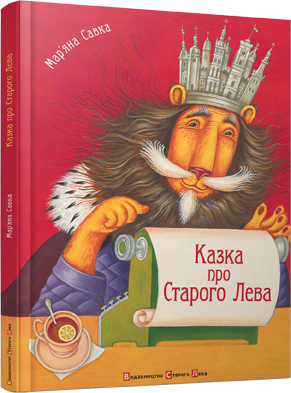 Perhaps, the strongest picturebook that features the Ukrainian landscape is A Tale about an Old Lion, written by a popular Ukrainian poet, Marjana Savka, and illustrated by Volodymyr Shtanko. A Tale about an Old Lion is a “postcard” of the “cultural” capital of Ukraine — the city of Lviv. The main character of this book is an Old Lion who settles on a mansard of the City Hall, which is home to the City Council and is one of the most cherished symbols in Lviv. From his perch there, the Lion admires picturesque views of the Old City. Since the weather is often rainy in Lviv, the Old Lion’s ceiling starts to leak. He needs immediate assistance with its major repairs and maintenance. His friends—a Crocodile, Elephant, and Giraffe—come to Lviv to help. On their way, the guests get into a number of misfortunes and turbulences, but in the end, the Mayor of the city welcomes all of them and invites them to enjoy Lviv. The story’s ending offers a verbal invitation to tourists all over the world to come to Lviv and see with their own eyes the welcoming atmosphere of an ancient city:
Perhaps, the strongest picturebook that features the Ukrainian landscape is A Tale about an Old Lion, written by a popular Ukrainian poet, Marjana Savka, and illustrated by Volodymyr Shtanko. A Tale about an Old Lion is a “postcard” of the “cultural” capital of Ukraine — the city of Lviv. The main character of this book is an Old Lion who settles on a mansard of the City Hall, which is home to the City Council and is one of the most cherished symbols in Lviv. From his perch there, the Lion admires picturesque views of the Old City. Since the weather is often rainy in Lviv, the Old Lion’s ceiling starts to leak. He needs immediate assistance with its major repairs and maintenance. His friends—a Crocodile, Elephant, and Giraffe—come to Lviv to help. On their way, the guests get into a number of misfortunes and turbulences, but in the end, the Mayor of the city welcomes all of them and invites them to enjoy Lviv. The story’s ending offers a verbal invitation to tourists all over the world to come to Lviv and see with their own eyes the welcoming atmosphere of an ancient city:Tell me, have you still not heard of the city of Lviv?
Hurry right now to book hundreds of tickets indeed.
Invite all your relatives and closest friends,
Come to Lviv soon, come to our land!
This is a city where you’re bound to be lucky,
Poets and singers think it’s just ducky!
There are squares, and cobblestones, shiny tram tracks,
And on the oldest mansard, the Lion still lives,
He drinks some tea and smokes a pipe,
And books for children he happily writes!
A Tale about an Old Lion offers not only vivid views of the city and the layouts of its famous landscapes, but also warm colors in the illustrations, brown and yellow, that depict a unique authentic state of both the old and contemporary Lviv. Since the city is often known as “the city of coffee” with its numerous coffee houses and pastry shops, this particular color palette is the best choice to recreate the aroma of the city.
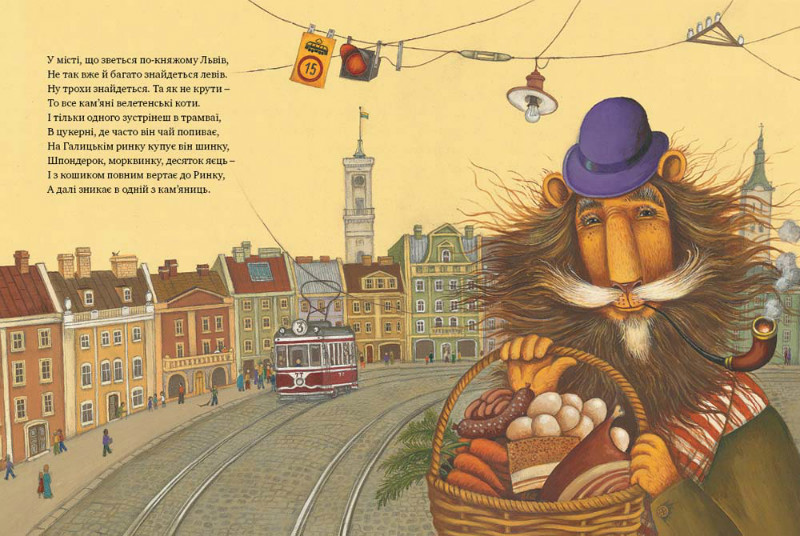
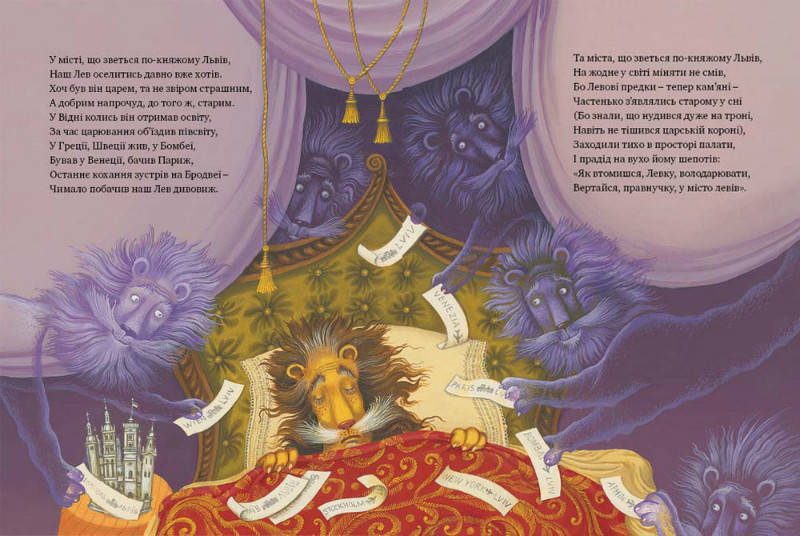
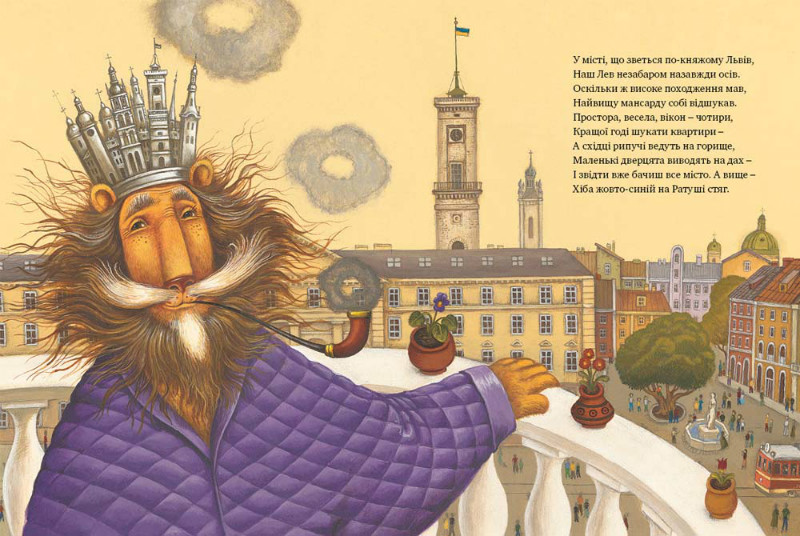
A Tale about an Old Lion was published in Lviv in 2011 by the Old Lion Publishing House. The book was awarded the Best Book of the Year Award and was included in the White Raven Online Catalogue, 2012.
The bilingual picturebook “Монетка”/A Coin is written by Ania Chromova and illustrated by Anna Sarvira. This playful story offers the universal experiences of a child: activities during daycare and relationships with parents and friends. When Romko receives a coin from his mother, he takes it to his daycare. Unfortunately, Romko has a hole in his pocket, and he losses the coin without noticing. At first he gets upset, but not for long, since he acquires something much more valuable — a rewarding communication with his father, who helps him to understand that humor and imagination can be essential to overcoming misfortune. While A Tale about an Old Lion represents Lviv, “Монетка”/A Coin recreates some geographical and cultural must-see places in Kyiv, the official capital of Ukraine. This book provides a vibrant visual experience that moves readers through the pages of an unfolding story. Additionally, it is important to mention that this book was published as part of the project A Step Ahead: Becoming Global with Bilingual Ukrainian-English Picturebooks, which is an on-going bilingual picturebook project that provides some important possibilities for literacy practices and developing global awareness. With the emphasis on two languages, this book provides advantages to learn from/about Ukrainian children’s literature, to familiarize readers with the Ukrainian language, to use this literature in educational settings and Ukrainian immigrant communities, and to assist Ukrainian readers in learning the English language. It also contributes to the body of bilingual picturebooks that offer a joyful reading experience.
Another book that was published through this project is a picturebook Скільки?/How many?, a poem written by Halyna Kyrpa and illustrated by Olha Havrylova.
The text of this poem raises many philosophical questions and might stimulate deep critical thinking:
Скільки у сонця промінчиків? / How many rays does the sun have?
А скільки хмарок у небі? / And how many clouds are in the sky?
А скільки піщинок на березі річки? / How many grains of sand are there on a riverbank?
А скільки хвиль у Дніпра? / And how many waves are in the Dnipro River?
Both “Монетка”/A Coin and Скільки?/How Many? were published in Kyiv in 2014 and 2015 by Bratske Publishers. Скільки?/How Many? is recommended by the Ukrainian “Critic’s Rating.”
A traditional Ukrainian folk tale, The Mitten, designed by Art Studio Agrafka (Andriy Lesiv and Romana Romanyshyn), is—to put it in Martin Salisbury and Morag Styles’ words (2012)—“‘the unique art’ of picturebooks” (p. 50). The story about a mitten is primarily known in the U.S. due to Jan Brett’s version.
A Ukrainian version of The Mitten was retold and recorded in the 19th century. It is a cumulative folktale that tells the story of how an old man loses his mitten in the forest and how a number of animals try to fit in it. Lesiv and Romanyshyn’s The Mitten not only has full-color illustrations, but also represents the meaningful and thoughtful process of creating a book as a cultural artifact. The designers masterfully reinterpret the traditional story and offer an adorable example of synthesis between text and image. Page by page, they demonstrate a number of design variations to introduce the artistic merits of contemporary Ukrainian illustrators and the printing technology available in Ukraine. The Mitten can generate a broad and “an effective cultural message” (Marcus, 2010, p. 49), while revealing a new version of a well-known folktale for English-speaking communities.
This picturebook was published by the Navchal’na Knyha – Bohdan Publishing House. It was included in the White Raven Catalogue, 2013 and was given an award by Biennial of Illustration Bratislava (BIB).
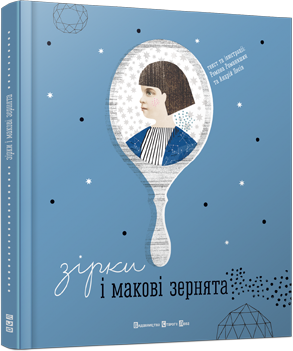 Another picturebook by Romana Romanyshyn and Andriv Lesiv, Stars and Poppy Seeds, narrates the story of a young girl, Dora, who is interested in mathematics. She is the daughter of well-known mathematicians, and she inherits her parents’ enthusiasm for figures and numbers. Dora counts everything around her: real and imagined animals, grains of rice, beads on her mother’s necklace, stars in the sky, and even poppy seeds. Figures are always in her head. While admiring the Milky Way, Dora plans to count all the particles of stardust. However, she finds this task to be impossible. Dora is upset, but her mother explains that to achieve any dream, one needs to handle challenging tasks by accomplishing small steps. Romanyshyn and Lesiv’s illustrations of mathematical, geometrical, and astronomical features connect readers with science, while emphasizing the humanities as well. Stars and Poppy Seeds was awarded the Bologna Ragazzi Award 2014 in the category of Opera Prima. It is translated into four languages (French, Korean, Spanish, and English). It was published in 2014 by the Old Lion Publishing House.
Another picturebook by Romana Romanyshyn and Andriv Lesiv, Stars and Poppy Seeds, narrates the story of a young girl, Dora, who is interested in mathematics. She is the daughter of well-known mathematicians, and she inherits her parents’ enthusiasm for figures and numbers. Dora counts everything around her: real and imagined animals, grains of rice, beads on her mother’s necklace, stars in the sky, and even poppy seeds. Figures are always in her head. While admiring the Milky Way, Dora plans to count all the particles of stardust. However, she finds this task to be impossible. Dora is upset, but her mother explains that to achieve any dream, one needs to handle challenging tasks by accomplishing small steps. Romanyshyn and Lesiv’s illustrations of mathematical, geometrical, and astronomical features connect readers with science, while emphasizing the humanities as well. Stars and Poppy Seeds was awarded the Bologna Ragazzi Award 2014 in the category of Opera Prima. It is translated into four languages (French, Korean, Spanish, and English). It was published in 2014 by the Old Lion Publishing House.In a nutshell, these are five selected Ukrainian picturebooks that I wanted to share with enthusiasts of children’s literature, but there are many, many others! Additionally, I want to say that the English translations of the texts of these picturebooks are available. Starting in the summer of 2013, I co-translated these picturebooks, together with Michael M. Naydan, a professor at Pennsylvania State University, and cherish a wish that one day these books will be published in the U.S. and reach U.S. readers.
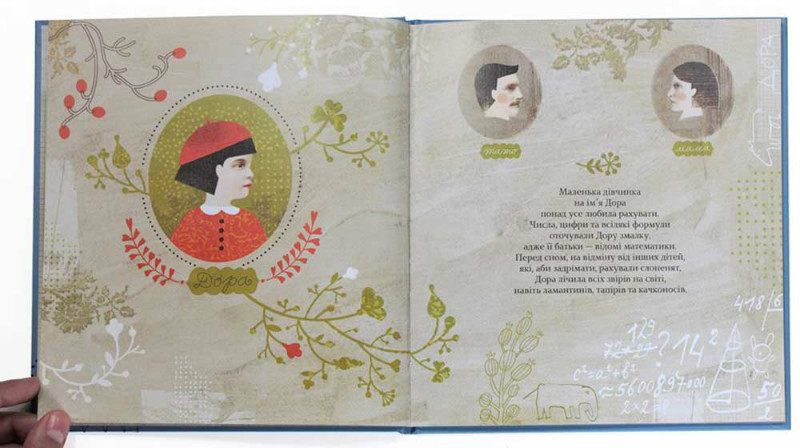
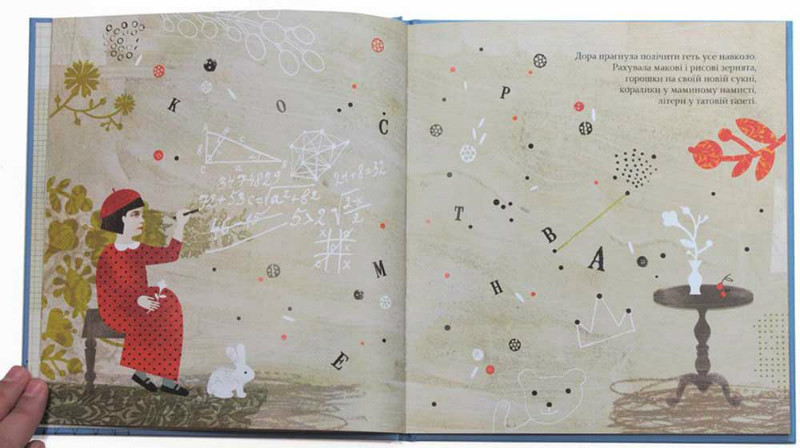
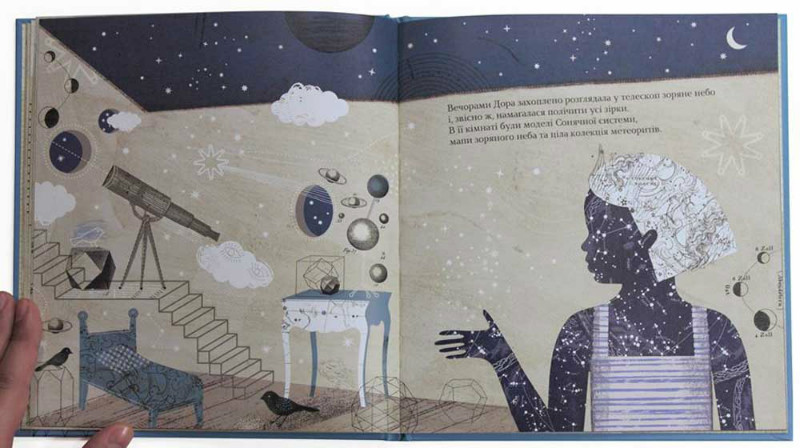
In her article “Where Worlds Meet,” Maria Machado (2011) reinterprets the possibility of building and extending an understanding of humankind by touching on the marvelous diversity between cultures (p. 397). She believes that representing the art of literature created all over the world will provide opportunities to cross borders, to meet neighbors, to get to know different people, and to see a variety of landscapes. Moreover, it will offer the possibility of fueling readers with unknown languages and authentic reflections of their otherness. Machado raises the question: “… why not meet otherness through what otherness creates?” (p. 398). Indeed, I believe that the best way to represent the rich experiences of voices from many countries is to translate and read what is created and written in them. In this scope, contemporary picturebooks for children from Ukraine not only represent creative approaches and perspectives of Ukrainian authors and artists, but invite readers to enjoy many exciting literary journeys. Today, Ukrainian children’s literature strives to claim its place on the international stage, so why shouldn’t we welcome it?
References
Khromova, A. (2015). “Монетка”/A coin. Kyiv, Ukraine: Bratske Publishers.
Kyrpa, H. (2014). Скільки?/How many? Kyiv, Ukraine: Bratske Publishers.
Machado, A.M. (2010). “Where worlds meet.” In Shelby Wolf et al. (Eds.), Handbook of research on children’s and young adult literature (pp. 397-403). New York, NY: Routledge.
Marcus, L. S. (2010). “Outside over where?: Foreign picture books and the dream of global awareness.” The Horn Book, 86(6), 45.
Romanyshyn, R., & Lesiv, A. (2012). The mitten. Ternopil, Ukraine: Navchal’na Knyha – Bohdan.
Romanyshyn, R., & Lesiv, A. (2014) Stars and poppy seeds. Lviv, Ukraine: Old Lion Publishing House.
Savka, M. (2011). A tale of old lion. Lviv, Ukraine: Old Lion Publishing House.
Коментарі
Щоб залишити коментар, необхідно